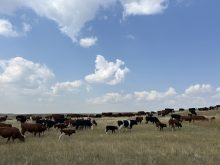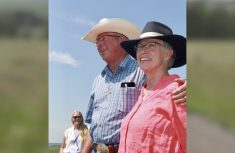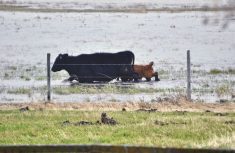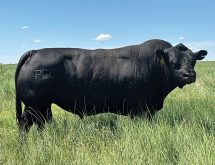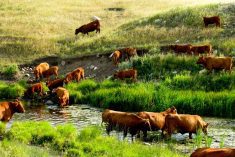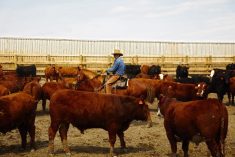In September 2022, Canadians who live in the Maritimes watched with apprehension as Hurricane Fiona moved from the Dominican Republic and Puerto Rico toward Canada’s East Coast. By the time the storm reached Atlantic Canada, it had been downgraded to a tropical storm, but that didn’t lessen the damage it caused as it swept across the Maritimes.
Fiona hit the East Coast with winds of 100 km an hour, which knocked down power lines, trees and more. In some areas, evacuations were necessary, and over two to three days, homes were dragged out to sea, diminished to piles of rubble.
For cattle producers, who make their living off the land, the force of a natural disaster, such as Fiona, threatened their livelihood.
Read Also

Canadian Beef Check-Off Agency reports on investments and activities
The check-off agency’s work behind the scenes is what ensures cattle check-off dollars are invested wisely, accounted for transparently and deliver measurable value back to producers and importers.
Now, two-and-a-half years later, the storm’s repercussions are still being felt.
“Mother Nature, she’s the boss”
Dean Manning’s family has been farming since the 1960s, located near Falmouth N.S., which is just off the Minas Basin. They have a cow-calf operation, in addition to some crops and greenhouses where they grow vegetables and fruit. According to their website, their goal is to produce food for the community in an ecologically sound and sustainable manner.
In 2021, Manning Farm was the winner of the Environmental Sustainability Award (TESA), the first in Nova Scotia to receive the coveted award.
“The geography and the landscape is quite a bit different,” Manning says, comparing the Prairies to the Maritimes.

Manning has dealt with his fair share of hurricanes and tropical storms. Sometimes many years go by without one making landfall, but in the past few years, they seem more frequent.
For him, Hurricane Fiona left a lasting impression.
“That’s the one that did a lot of damage,” he says. “It wasn’t directly over our farm here, but it was at the pasture that we keep cattle in. Pictures don’t do it justice… You’ve just kind of got to get boots on the ground, really, to see. It’s unlike anything.”
He says many of their trees got knocked over during the storm, and there was quite a bit of damage to their fences as well. Inches of rain fell, leaving the ground so wet that the root balls of trees uprooted.
For Manning, there wasn’t much he could do to prepare before or during the hurricane — he could only hope for the best and return after to assess the damage.
“I know that Hurricane Fiona, we went (to the pasture) the day after… but we weren’t even sure on the roads if we were going to get there, because power lines were down across the roads,” Manning says.
“You just really kind of wait it out, and then when it’s done, clean the mess up. There’s only so much you can do because Mother Nature, she’s the boss.”
It took Manning two full days after the hurricane to clear fallen trees and broken fences, enough so he could continue with work. However, even two years later, there is still cleanup remaining.
“We just pick away at it. We cleaned what was on the fence, but (trees are) still lying down up to the fence and that sort of thing. But it takes time to do that.”
A hard decision
For Dwain MacAulay, everything changed when Hurricane Fiona swept in from the Atlantic.
MacAulay owned and operated Harbour View Farm, a small operation on the coast of Prince Edward Island. The farm had been in his family for six generations, and he had about 40 head of commercial cattle on 200 acres. From his location, he could look over the harbour and into the ocean — the view that gave the farm its name.
When Hurricane Fiona made landfall, MacAulay had no idea how bad of a storm it would be — and that it would eventually force him out of the cattle business.

“It hurt really bad. I didn’t want to get out of farming,” MacAulay says.
They didn’t know what the path of the hurricane would be until a few hours before it reached P.E.I. Fiona’s maximum wind speed while in Atlantic Canada was 105 mph, and rainfall exceeded 90 mm in some areas of P.E.I.
MacAulay did his best to prepare his farm, but there is only so much you can do when faced with a hurricane. So he hunkered down and hoped for the best.
But the storm dashed his hopes. Fiona knocked down his cattle barn, which was a significant blow to his operation. He also lost his grain tank, many trees, and the storm destroyed his fence lines.
However, it was the loss of his cattle barn that forced him to consider his now precarious place in the industry. His cows calved from January to March, and without the barn, he’d have nowhere to put them.
He’d hoped there would be some kind of government support to help him to rebuild. However, the relief programs offered were not enough to cover the expenses of a new barn.
“After it was over, (the government was) saying, ‘No, don’t worry. It’ll be looked after.’ But it was never enough to move forward.”
Because none of MacAulay’s children were interested in continuing the farm after MacAulay, he realized it would make the most economic sense to step away from the business.
“It was one of the hardest decisions I ever made, to be truthful. I had to think with my head and not my heart in this situation.”
So he sold his herd and resigned from his position on the board of the Prince Edward Island Cattle Producers Association.
Even years later, leaving the industry is a blow MacAulay hasn’t quite recovered from.
“I had generations before me that farmed, so you almost felt like you disappointed the generation before you.”
The aftermath
Hurricanes have always been a concern for those who live in Atlantic Canada, but in recent years, the storms seem more frequent. Generally, in a hurricane season, the average number of hurricanes is three.
In 2024, there were 11 hurricanes in the Atlantic.
Though it is hard for climate scientists to pinpoint exactly how the changing climate affects hurricanes, an increase in sea surface temperature causes storms to pick up more energy which leads to higher wind speeds. An increase in atmospheric temperatures can lead to more moisture, which can increase rainfall.
Hurricanes are caused by the interaction of warm, moist seawater and warm air.
Following Hurricane Fiona, the federal government provided a Hurricane Fiona recovery fund for those affected by the storm. Both Nova Scotia and Prince Edward Island offered funding to cover some expenses related to the storm. But Prince Edward Island’s recovery program, which covered infrastructure damage, wasn’t launched until November 2023, after MacAulay had left the business.
Now over two years after the hurricane, both MacAulay and Manning are still dealing with it in different ways. Manning is still cleaning branches and trees that fell during the hurricane when he can.
He worries about another hurricane making landfall in the future, but for now, he carries on.
“It’s what we do. So, we’ll stay at it. And it could be 50 years before we get another hurricane too, or we could get one or two this year. But those are risks. I guess when you do anything, there are risks, and that’s just one of the risks,” Manning says.
For MacAulay, the wound of leaving the industry hasn’t fully healed. If he had it his way, he would still be raising cattle, but it’s not in the cards.
“If I won the lotto, I’d be back in the cattle today. A lot of us who do this, we do it because we enjoy it, it’s more a passion.”
For now, he rents out his land to neighbours who grow potatoes, because it is important to him that the land stays in agriculture. He’s also the superintendent of a golf course, an off-farm job he held before the hurricane.
His advice to farmers and ranchers who may deal with hurricanes at some point in their lives is to prepare as much as possible and to understand the risks.
“Don’t take (hurricanes) lightly anymore… and try to be as prepared as you can. And I don’t have the answers of how we do that.”



